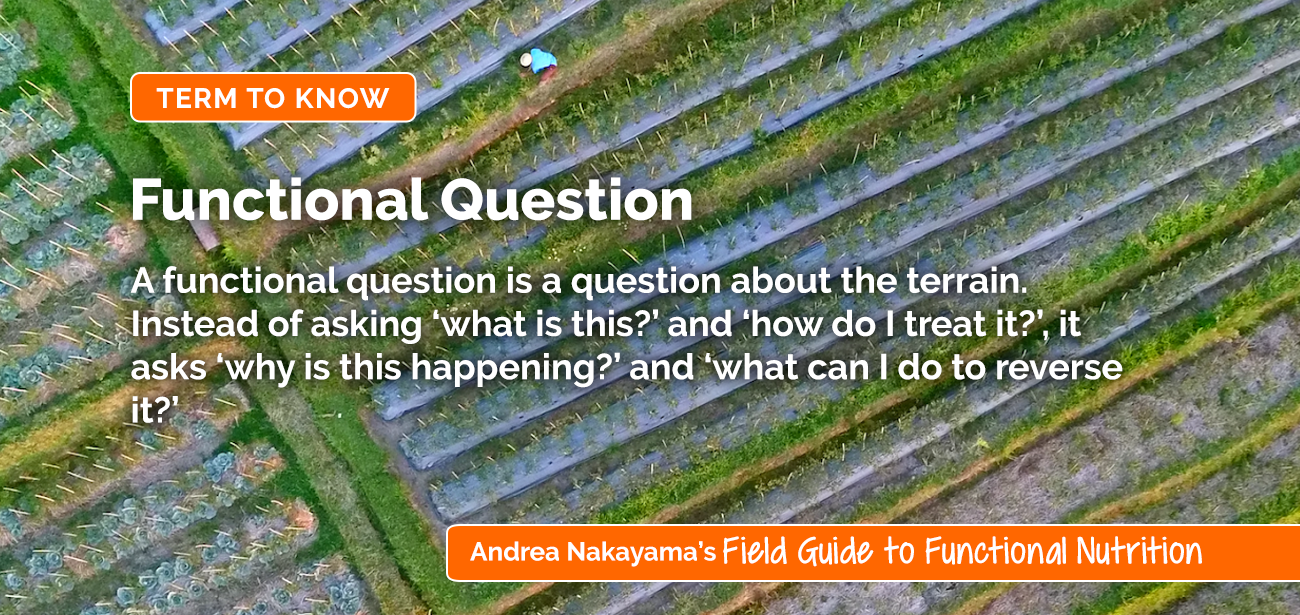Functional Question
Posted by Andrea Nakayama

Listen to this post instead!
A Functional question is a question about the terrain—it’s a question about the person. It’s not a question about the diagnosis.
A Functional question uses the principles of Functional empathy as well as the Functional Nutrition Matrix to make inquiries that lead to information about the bioindividuality of the client. Asking the Functional questions more readily leads to root cause resolutions and addresses what Dr. Dale Bredesen has termed the 36 holes in the roof. (Which of those holes might we need to plug?)
Here’s why…
Symptoms don’t arise in a vacuum.
Signs and symptoms only arise in an environment that has the perfect conditions for them to occur. Dr. Jeffrey Bland often says that “disease starts with dysfunction.” There are triggers and precipitating events that result in the appearance of a diagnosis.
Dysfunction often only results from myriad insults.
Those insults can be physical, physiological, psychological, spiritual, cognitive and more. These provocations may materialize in one individual over time or simultaneously, yet together they cloud the waters of care—until we learn to think Functionally.
It’s the coexisting conditions, manifesting together (and yet unique to the individual), that not only lead to a singular diagnosis, but also to the challenges that many of us practitioners experience in healthcare, particularly for those with chronic health challenges.
The Functional questions acknowledge that one-size-does-not-fit-all.
[bctt tweet=”A Functional question is about the person, not the diagnosis.” username=”AndreaNakayama”]
A Functional practitioner knows how to dig deeper, look upstream, and ask, “Why is the environment in this individual perfect for this particular symptom or condition?”
Once the terrain is understood, it can be shifted.
“A gardener sees the world as a system of interdependent parts—where healthy, sustaining relationships are essential to the vitality of the whole…A real gardener is not a person who cultivates flowers, but a person who cultivates the soil.”
– Karel Capek
Thinking Functionally is like being a “real gardener”—a gardener who cultivates the “soil” in an individual’s body.
I also like to think of the Functional question like a yogi thinks about mindfulness. Instead of an equation where a problem leads to a reaction, we insert a pause.
It looks something like this:
A question such as “what do I do for a client who has lupus?” is not a Functional question. A question like “where should I start with a client who is exhausted, is a new mom, is reacting to myriad foods and who was recently diagnosed with lupus?” starts to be more Functionally oriented.
Now see if you can turn your question into a Functional question.
Thinking functionally starts with true empathy. not just their diagnosis, —and it starts with knowing the right questions to ask.
EXPERIENCE A FREE TRAINING SERIES WITH ANDREA NAKAYAMA TO HELP YOU
Begin practicing functionally today!
MORE TO EXPLORE
You Might Also Like
Maya Simand: Cancer Survivor to Holistic Cancer Coach
Holistic cancer coach Maya Simand shares her inspiring journey to healing. Discover how Functional Nutrition education empowered her to overcome breast cancer and help others find hope through integrative approaches.
Read MoreEstrogen dominance and breast cancer prevention: A Functional Nutrition approach
Estrogen dominance is a key factor in ER+ breast cancer. This Functional Nutrition guide explores how estrogen dominance increases risk and provides practical strategies to balance hormones and support overall health.
Read MoreThe 3 Roots, Many Branches: A Functional Framework for Clinical Success
As practitioners or aspiring nutrition counselors, we’re all familiar with the frustration of watching people struggle with chronic illness, cycling through symptoms and diagnoses without resolution.
Read MorePutting Patients First with Patient-Centered Care
I recently read an account written by a primary care doctor (PCP) describing a patient who had been passed from one specialist to another—each one focusing on ordering tests, prescribing medications, and ultimately sending her off with more questions than answers. No one paused to truly listen to the patient’s story. No one asked about […]
Read More
